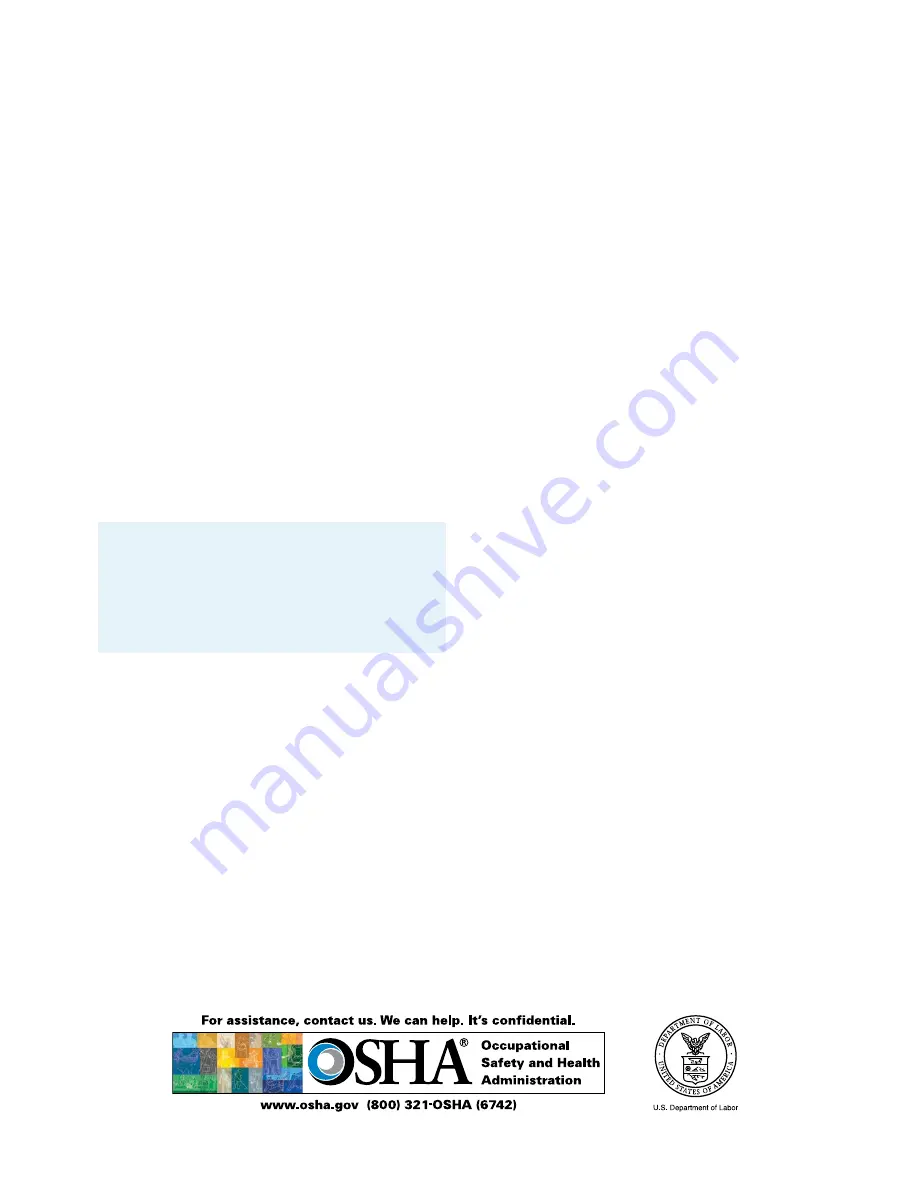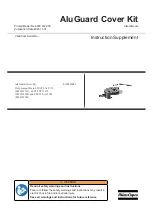
DSG FS-3697 09/2014
This is one in a series of informational fact sheets highlighting OSHA programs, policies or standards.
It does not impose any new compliance requirements. For a comprehensive list of compliance
requirements of OSHA standards or regulations, refer to Title 29 of the Code of Federal Regulations.
This information will be made available to sensory-impaired individuals upon request. The voice phone
is (202) 693-1999; teletypewriter (TTY) number: (877) 889-5627.
• Provide accommodations for end-of-shift
showers and change areas with separate
storage facilities for street clothes, protective
clothing and equipment.
• Keep contaminated clothing and equipment
out of the clean change area.
Respiratory Protection
An abrasive-blasting respirator must cover the
wearer’s head, neck, and shoulders to protect
the wearer from rebounding abrasive. Workers
must use only respirators approved by
NIOSH
to
provide protection from dusts produced during
abrasive-blasting operations.
• Type CE NIOSH-certified blasting airline
respirator with positive pressure blasting
helmet.
Support personnel involved in cleanup and
other related activities may also need respiratory
protection.
Personal Protective Equipment
• Hearing protection
• Eye and face protection
• Helmet
• Leather gloves that protect to full forearm and
aprons (or coveralls)
• Safety shoes or boots
Worker Training and Hazard Communication
• Provide training to abrasive blasters and
support personnel on blasting health and
safety hazards, how to use controls, personal
hygiene practices, safe work practices and the
use of PPE and respirators.
• Manufacturers are required to include
appropriate health hazard information on
the blasting materials on safety data sheets
(SDS) as required under OSHA’s Hazard
Communication standard (
29 CFR 1910.1200
).
• Obtain and read the manufacturer’s SDS for
health hazard information on the abrasive
blasting material you are using.
For more information on abrasive blasting
and control measures see: OSHA’s guidance
document:
“Abrasive Blasting Hazards in
Shipyard Employment” (2006)
; and
eTool:
Mechanical Removers (Ship Repair)
.
When respirators are used, employers must
establish a comprehensive respiratory
protection program as required by the
OSHA
Respiratory Protection standard (29
CFR 1910.134)
.
Disclaimer: This OSHA Fact Sheet provides a general overview of the requirements in OSHA standards related to abrasive blasting.
It does not alter or determine compliance responsibilities in these standards or the
Occupational Safety and Health Act of 1970
. Since
interpretations and enforcement policy may change over time, the reader should consult current OSHA interpretations and decisions by
the Occupational Safety and Health Review Commission and the courts for additional guidance on OSHA compliance requirements.
© 2020 Hess & Associates
Man. # 561 v02-02 8/2020
Page 5
Содержание LB4024
Страница 20: ...Little Blaster STANDARD CABINET ASSEMBLY PARTS 2020 Hess Associates Man 561 v02 02 8 2020 Page 18 ...
Страница 21: ...Little Blaster LIGHT BOX ASSEMBLY PARTS 2020 Hess Associates Man 561 v02 02 8 2020 Page 19 ...
Страница 22: ...Little Blaster MACHINE AIR CONTROLS PARTS 2020 Hess Associates Man 561 v02 02 8 2020 Page 20 ...
Страница 23: ...Little Blaster CARTRIDGE DUST COLLECTOR PARTS 2020 Hess Associates Man 561 v02 02 8 2020 Page 21 ...
Страница 25: ...Little Blaster Electrical Diagram 2020 Hess Associates Man 561 v02 02 8 2020 Page 23 ...








































